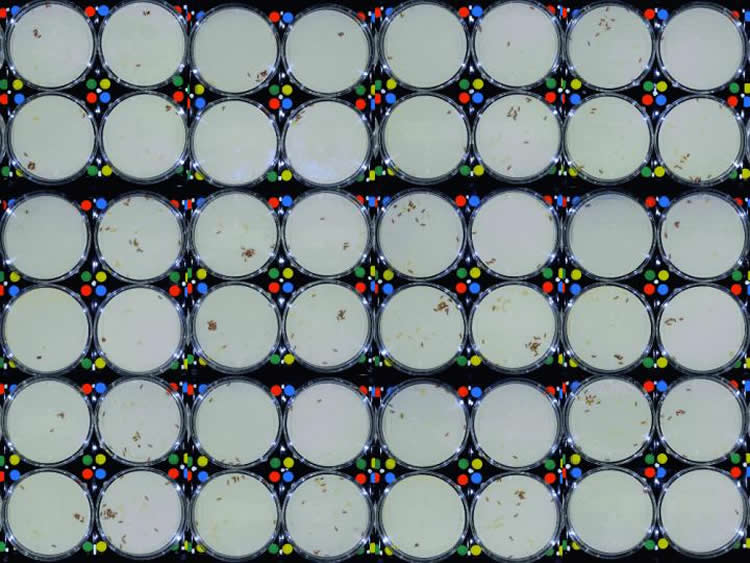Summary: A new study of ant populations reveals group living confers immediate benefits, even among genetically identical individuals. The study revealed larger groups produced more offspring and greater stability than smaller groups. The study may shed new light on the evolution of social behavior.
Source: Rockefeller University.
Common wisdom suggests that two heads are better than one. Yet, two heads can also butt–and when resources are scarce, competition may seem more attractive than collaboration. With that in mind, biologists have long wondered how civil societies evolve.
“You would think, if you pair similar individuals from a single species, their function would be redundant, If anything, there should be competition between individuals,” says Daniel Kronauer, the Stanley S. and Sydney R. Shuman Associate Professor. However, in a recent study published in Nature, Kronauer shows that group living confers immediate benefits, even among genetically identical individuals.
Over a 45-day period, Kronauer’s team monitored clonal raider ants (Ooceraea biroi) in groups ranging in size from 1 to 16 individuals. They observed that larger groups produced more offspring and experienced greater stability than smaller groups. The bigger groups also exhibited a greater division of labor: even though the ants were extremely similar, group living somehow prompted the insects to specialize in particular tasks.

Specialization isn’t the only advantage of living in a group, however. In developing a mathematical model, the researchers were able to determine, among other things, that increased group size led to increased stability, regardless of whether the ants divided their responsibilities. “You don’t need specialization to see an effect, but with specialization the effect becomes stronger,” says Kronauer.
Results from both the ant observations and the model indicate that individuals benefit from group living even when those groups are quite small–a finding that has significant implications for understanding the evolution of social behavior.
“It’s easy to see how individuals work together in more complex societies, such as those with queens and workers, because they have distinct roles. But that’s not how insect societies started out,” says Kronauer. “This research shows that very simple societies can have an evolutionary advantage over individuals living by themselves–which provides a stepping stone to understanding how complex societies evolved from solitary animals.”
Funding: Funding for the study was provided by the National Institutes of Health, Searle Scholar Award, Klingenstein-Simons Fellowship Award in the Neurosciences, Pew Biomedical Scholar Award, Swiss National Science Foundation, Rockefeller University, and others.
Source: Lori Chertoff – Rockefeller University
Publisher: Organized by NeuroscienceNews.com.
Image Source: NeuroscienceNews.com image is credited to Yuko Ulrich and Asaf Gal.
Original Research: Abstract for “Fitness benefits and emergent division of labour at the onset of group living” by Y. Ulrich, J. Saragosti, C. K. Tokita, C. E. Tarnita & D. J. C. Kronauer in Nature. Published August 22 2018.
doi:10.1038/s41586-018-0422-6
[cbtabs][cbtab title=”MLA”]Rockefeller University”Ant-y Social: Ant Study Reveals Evolutionary Benefits of Group Living.” NeuroscienceNews. NeuroscienceNews, 23 August 2018.
<https://neurosciencenews.com/ant-social-group-living-9731/>.[/cbtab][cbtab title=”APA”]Rockefeller University(2018, August 23). Ant-y Social: Ant Study Reveals Evolutionary Benefits of Group Living. NeuroscienceNews. Retrieved August 23, 2018 from https://neurosciencenews.com/ant-social-group-living-9731/[/cbtab][cbtab title=”Chicago”]Rockefeller University”Ant-y Social: Ant Study Reveals Evolutionary Benefits of Group Living.” https://neurosciencenews.com/ant-social-group-living-9731/ (accessed August 23, 2018).[/cbtab][/cbtabs]
Abstract
Fitness benefits and emergent division of labour at the onset of group living
The initial fitness benefits of group living are considered to be the greatest hurdle to the evolution of sociality, and evolutionary theory predicts that these benefits need to arise at very small group sizes. Such benefits are thought to emerge partly from scaling effects that increase efficiency as group size increases. In social insects and other taxa, the benefits of group living have been proposed to stem from division of labour which is characterized by between-individual variability and within-individual consistency (specialization) in task performance. However, at the onset of sociality groups were probably small and composed of similar individuals with potentially redundant—rather than complementary—function1. Self-organization theory suggests that division of labour can emerge even in relatively small, simple groups. However, empirical data on the effects of group size on division of labour and on fitness remain equivocal6. Here we use long-term automated behavioural tracking in clonal ant colonies, combined with mathematical modelling, to show that increases in the size of social groups can generate division of labour among extremely similar workers, in groups as small as six individuals. These early effects on behaviour were associated with large increases in homeostasis—the maintenance of stable conditions in the colony—and per capita fitness. Our model suggests that increases in homeostasis are primarily driven by increases in group size itself, and to a smaller extent by a higher division of labour. Our results indicate that division of labour, increased homeostasis and higher fitness can emerge naturally in social groups that are small and homogeneous, and that scaling effects associated with increasing group size can thus promote social cohesion at the incipient stages of group living.






